Extinction Rebellion: who are they and what do they want?
Thousands of them have brought cities to a halt. Who are these protesters, and what do they want?
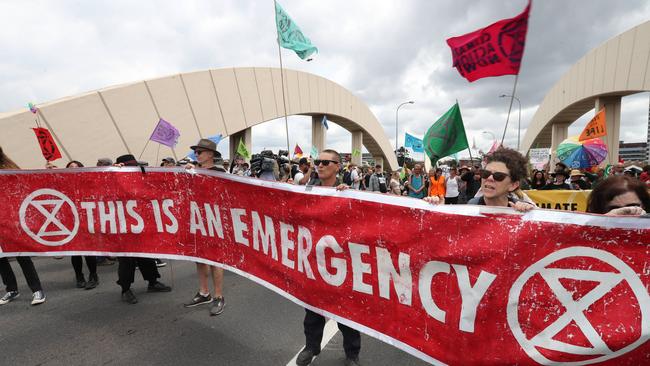
Thousands of them have been arrested globally this year, they have blocked roads and brought cities to a halt. Who are Extinction Rebellion? What do they want and where did they come from?
Who are Extinction Rebellion’s members?
Extinction Rebellion, who also call themselves XR, is a grassroots global group committed to “a moral duty to rebel’’ in the face of challenges to biodiversity and consequently, societies. The group has thousands of members from under 18 to over 80 years in more than 59 countries. They began in the United Kingdom in 2018, originally formed by members of the social justice organisation Rising Up!
Aren’t they just like Greenpeace or Sea Shepherd?
Both Greenpeace and Sea Shepherd are large NGOs with a business model. Extinction Rebellion has a decentralised structure and promotes mass disobedience as their primary strategy for change, unlike Greenpeace or Sea Shepherd. There may be an overlap of members or supporters.
In the first Extinction Rebellion demonstration in October 2018 in London, protesters occupied the Greenpeace office, calling on the NGO to ‘up their game.’
What do they want?
Extinction Rebellion has three demands:
1. The government must “tell the truth’’ by declaring a climate emergency.
2. The government must reduce greenhouse gas emissions to net zero by 2025 to arrest biodiversity loss.
3. The creation of a “Citizen’s Assembly’’, a group of ordinary people brought together to discuss and investigate options to respond to the climate emergency. Individuals will be selected for the Assembly via a practice similar to jury duty. The group cites Melbourne’s People’s Pane l as an example of a successful citizen’s assembly.
What is their strategy?
Extinction Rebellion favours civil disobedience over traditional methods of protest, like writing to your local member of parliament or petitions.
Their strategy of mass disruption of communities through nonviolent civil disobedience is inspired by sit-in protests like the Occupy Wall Street movement.
While the primary aim is not necessarily to be arrested, George Monbiot declared in his 31st October 2018 speech at the Declaration of Rebellion against the UK Government: “The only time that people know it is serious, is when people are prepared to sacrifice their liberty in defence of their beliefs.”
What are some of the most notable exhibitions of civil disobedience?
The London die-in
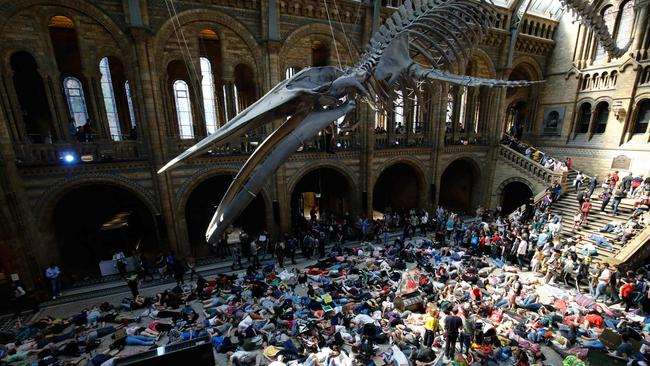
About 100 protesters in London laid underneath the skeleton of a blue whale at the Natural History Museum in London.
Protesters stripped down in the UK House of Commons
BREAKING: Extinction Rebellion activists strip off in House of Commons public gallery to call attention to the ‘elephant in the room’ — Climate and Ecological Crisis #ExtinctionRebellion #TellTheTruth @HouseofCommons pic.twitter.com/VO8l31XRne
— Extinction Rebellion âŒ›ï¸ (@ExtinctionR) April 1, 2019
In April 2019, some protesters glued themselves to the front of the public gallery and stripped down.
Fake blood on New York’s statues
The fearless girl statue stands amidst fake blood outside of the New York Stock Exchange after a Extinction Rebellion protest #nyc #newyork #ExtinctionRebellion pic.twitter.com/rKv2dZsqnV
— Adam Gray (@agrayphoto) October 7, 2019
Both the fearless girl statue and the charging bull statue in New York were covered in red paint to simulate fake blood. A number of red rebels were on the seen.
A man has glued himself to a plane
Paralympian James Brown climbed on top of a British Airways Plane at London City Airport in October 2019 in specific protests of the carbon emissions air travel produces.
Hanging from a bridge in Brisbane
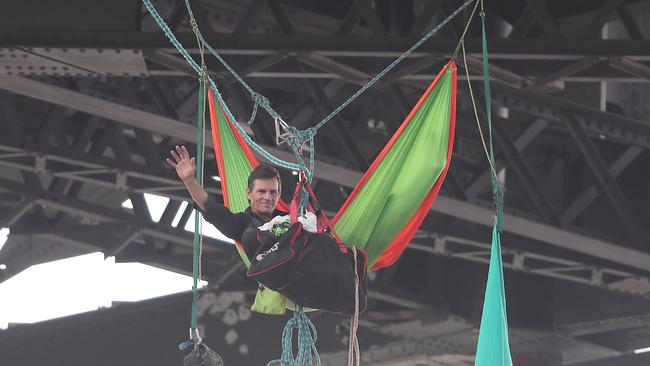
In Brisbane a protester suspended from the city’s Story Bridge says climate change caused a recent Queensland bushfire that destroyed the forest where his wife’s ashes were scattered.
Heads in the sands
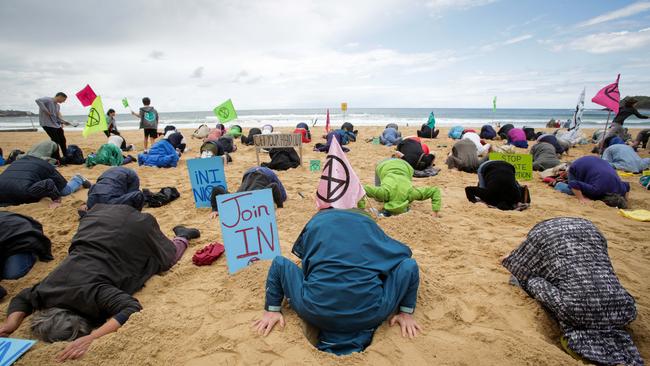
Bee-mergence
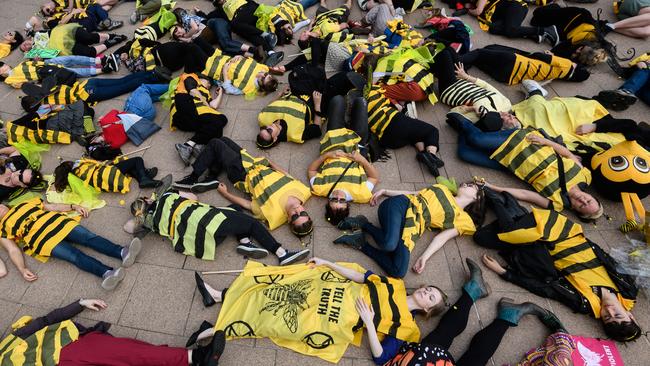
Six protesters posing as dead bees were arrested at Hyde Park in Sydney in October 2019.
Have they had any success?
Some, yes. The first of their demands is that governments “tell the truth’’ and declare a climate emergency. Shortly after the April 2019 staging of civil disobedience in London, the British parliament declared a climate emergency. A few weeks later, the UK parliament pledged to be carbon neutral by the year 2050, which is 25 years past the time deadline demanded by Extinction Rebellion.
The Australian government has not responded to any of the three demands.
What’s with the pink boat?

In the second exhibition of civil disobedience staged in London in April 2019, a pink boat became the mascot of the protest at Oxford Circus for five days before it was dismantled by police. The boat, named Berta Cáceres in memory of the murdered Honduran environmental activist, had the group’s first demand, “tell the truth’’ emblazoned on the side.
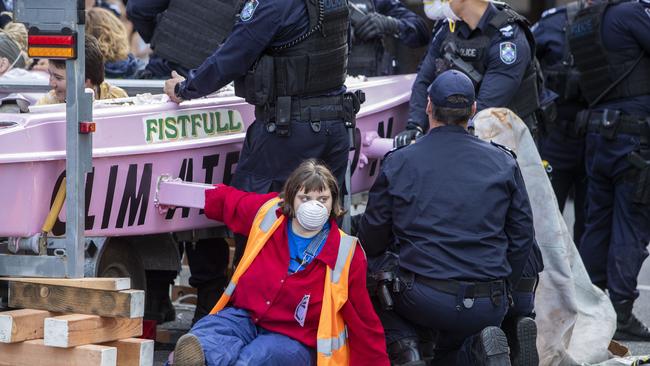
The pink boat became an icon for protests in Washington in September 2019, Dublin in October 2019, and most recently at the Brisbane protest. A green boat has appeared in the Times Square protest this month with the group’s second demand painted to the side: Act Now.
63 arrests and a boat⛵ dropped in Times Sq.
— Extinction Rebellion NYC 🌎 (@XR_NYC) October 10, 2019
No more business as usual.
The seas are rising and so are we!#ClimateEmergency #ExtinctionRebellion
Help us keep the momentum going! A lot of us are paying out of pocket https://t.co/AP5O87GEQT pic.twitter.com/5a6M3XfUEc
After the original pink boat in London was dismantled by police, signs appeared reading “we are the boat,” as did makeshift cardboard vessels. A more permanent structure, a blue boat named Polly Higgins after the environmental activist and barrister who spent the final decade of her life fighting to make ecocide a crime in the International Criminal Court, appeared. The boat has been on display at the National Maritime Museum in Greenwich this year.
Extinction Rebellion have named their blue boat outside the Royal Courts of Justice the 'Polly Higgins' after the barrister and environmental lobbyist who died earlier this year. pic.twitter.com/kXHgeHidi4
— LBC (@LBC) July 15, 2019
The boat draws attention to the rising sea levels predicted by the Intergovernment Panel on Climate Change. The most recent report claims that sea levels could rise by 30-60cm by the year 2100 even if greenhouse gas emissions are sharply reduced and global warming is kept to below 2 degrees. Without these measures, sea levels could rise 60-110cm.
… and the people who are dressed in red?
#RedRebels at Potsdamer Platz #BerlinBlockieren pic.twitter.com/ujpt57qrsP
— Extinction Rebellion Deutschland (@ExtinctionR_DE) October 7, 2019
The Red Rebel Brigade, or their global imitating supporters, have appeared in London, Spain, Australia and Berlin. The group, created by the Bristol Street performance group called the Invisible Circus, is not only linked to Extinction Rebellion. The red rebels first appeared politically in 2001 in protest of the Iraq war. Wearing a striking bright red, the brigade act in mime and a series of tableaus.
What about the unusual street dances?
Progressives 😂😂😂😂 pic.twitter.com/nQgL0nm0hx
— 🎀кєℓℓιє🎀 (@kelliekelly23) October 7, 2019
In their own words: “Some, though not all of us, have a “spiritual” orientation and we welcome anyone regardless of their beliefs. We think that people protect the things that they love and that embracing our love of life and the natural world is not something we should shy away from.”




To join the conversation, please log in. Don't have an account? Register
Join the conversation, you are commenting as Logout